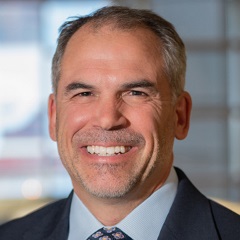Articular Cartilage Repair Helps Restore Damaged Knee Joints
Procedure provides non-invasive option to deliver new life to injured joints
 DAYTON, Ohio (October 1, 2019) – Painful joints don’t always point to the need for replacement surgery, particularly in cases in which articular cartilage in the knee has been damaged by injury.
DAYTON, Ohio (October 1, 2019) – Painful joints don’t always point to the need for replacement surgery, particularly in cases in which articular cartilage in the knee has been damaged by injury.
Articular cartilage is the smooth, white tissue covering the ends of bones where they form joints, allowing them to move with very little friction. When cartilage becomes damaged due to general wear and tear or injury, it does not easily heal on its own and requires surgical intervention. Thankfully, patients now have a variety of treatment options that can be used to restore healthy joints. These procedures help prevent or delay further wearing away of cartilage, which can lead to osteoarthritis as bone rubs against bone, eventually requiring joint replacement surgery.
A relatively new procedure known as Matrix-induced Autologous Chondrocyte Implantation (MACI) removes a patient’s healthy tissue from a non-weight bearing area and grows new tissue that is later implanted into the affected area.
“Recently the Food and Drug Administration approved a refinement of the MACI procedure which improves results and reduces complications and recovery time,” said Eric Fester, MD, an orthopedic surgeon with Premier Orthopedics. “It’s a nice even fill of the defect with a high density of cartilage cells, so it grows in better.”
In the new version of MACI, the cartilage cells are grown in a lab up to 10 times their original size on a membrane, which is glued in the joint. This reduces the time of the transplant from about two and a half hours to 45 minutes. The new process provides a uniform distribution of cartilage cells on the membrane.
“Articular cartilage restoration procedures are most commonly done in knee joints. But it can be done in ankles and shoulders, too, though it’s not intended for those with cartilage damage from osteoarthritis,” said Dr. Fester. “The difference is that these procedures are designed to repair a specific area due to cartilage defect or injury, instead of overall cartilage wear and tear degeneration that affects the entire joint.”
Younger, active patients with a single injury often make the best candidates, as opposed to older patients with numerous injuries and arthritis. Ultimately, an orthopedic surgeon is the best resource to determine if a patient would benefit most from treatment. Articular cartilage repair is typically broken down into the following categories:
- Repair- Arthroscopic surgery is used to retrieve damaged cartilage and reattach it to the bone by using pins or screws.
- Microfracture - Microfracture techniques help stimulate growth of new articular cartilage by creating a new blood supply. Using arthroscopic techniques, the surgeon drills miniature holes into the bone at the affected area, allowing blood to flow and clot and enabling the growth of new cartilage.
- Abrasion Arthroplasty- Abrasion is similar to microfracture, but simply uses high speed burrs in place of drills to remove damaged tissue and stimulate blood flow for cartilage formation.
- Denovo technique- Denovo is similar to MACI, but uses young donor cartilage which is then implanted into the patient. This procedure is not as effective as MACI because the patient’s own tissue is not used.
Despite the benefits of these procedures, there is always the risk that the repaired areas do not heal properly or fail to foster new cartilage growth. In this case, a full joint replacement may be required. Still, Dr. Fester says that a variety of factors play important roles in helping to determine which of these techniques is best for a patient to achieve optimal results.
“Though cartilage restoration may not be right for everyone, other things – such as the size and location of the affected area, a person’s age and activity level, as well as an evaluation of any other preexisting conditions – can help us decide how we should proceed,” said Dr. Fester, who practices with Premier Physician Network.
The great news for patients today is that there is a broad range of care that specialists can use to address their specific needs, regardless of the stage of their injury or pain level. This might include physical therapy or non-surgical interventions such as platelet rich plasma (PRP) or stem cell injections to help restore damaged tissue, surgical repair, or a complete joint replacement. Each patient is carefully evaluated and a custom treatment plan is created and delivered by a team of specialists.
For more information about articular cartilage repair or to find a Premier Physician Network physician near you, visit www.PremierPhysicianNet.com/Provider.
Contact Us
Discover more about Premier Health and join us in building healthier communities in Southwest Ohio. Learn more about working at Premier Health, becoming a volunteer, and making a gift to support our mission.

